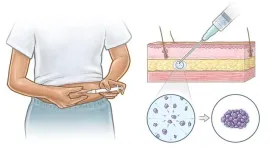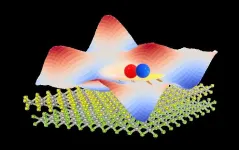Type 2 diabetes may suppress reward
Rat study suggests that Type 2 diabetes may weaken a projection in the brain that drives reward and spatial processing.
2025-03-24
(Press-News.org) The high comorbidity of type 2 diabetes (T2D) with psychiatric or neurodegenerative disorders points to a need for understanding what links these diseases. A potential link is the anterior cingulate cortex (ACC). The ACC supports behaviors related to cognition and emotions and is involved in some T2D-associated diseases, like mood disorders and Alzheimer’s disease (AD). James Hyman and colleagues, from the University of Nevada, Las Vegas, used a rat model of T2D that affects only males to explore whether diabetes affects ACC activity and behavior. Their work is featured in JNeurosci’s Computational Properties of the Prefrontal Cortex Special Collection.
The researchers examined ACC activity and behavior as male rats sought rewards in a cognitively demanding maze. All rats pursued rewards, but areas where rewards were received were less salient to those with T2D; these rats had weaker ACC reward signals in these locations and did not stay there long. The researchers pinpointed the weakened reward signal to a dampened input into ACC from the hippocampus, which is involved in spatial memory. “We think the hippocampus tells the rat where it is in the maze, and the ACC tells the rat what it is doing and that it’s getting a reward. These things should come together and make the rat remember it was just in a special, rewarding location, but this doesn’t happen with the ones that have T2D,” says Hyman. This study highlights the close relationship T2D has with reward and spatial processing. According to the authors, the hippocampus-to-ACC projection may be worth exploring as a treatment target for mood disorders to which the ACC is already linked. Hyman also emphasizes that because this projection contributes to mild cognitive impairment preceding AD, “Diabetes may be altering the brain similarly to early stages of AD. AD goes undetected for decades because our brains are good at finding ways to adapt. Before diagnosis, people behave normally despite having changes in information processing. We even observed that in this study! Diabetic rats still went to receive the reward, but their experience differed compared to healthy animals.”
###
Please contact media@sfn.org for full-text PDF.
About JNeurosci
JNeurosci was launched in 1981 as a means to communicate the findings of the highest quality neuroscience research to the growing field. Today, the journal remains committed to publishing cutting-edge neuroscience that will have an immediate and lasting scientific impact, while responding to authors' changing publishing needs, representing breadth of the field and diversity in authorship.
About The Society for Neuroscience
The Society for Neuroscience is the world's largest organization of scientists and physicians devoted to understanding the brain and nervous system. The nonprofit organization, founded in 1969, now has nearly 35,000 members in more than 95 countries.
END
ELSE PRESS RELEASES FROM THIS DATE:
2025-03-24
Embargoed for release: Monday, March 24, 12:00 PM ET
Key points:
Maintaining a healthy diet rich in plant-based foods, with low to moderate intake of healthy animal-based foods and lower intake of ultra-processed foods, was linked to a higher likelihood of healthy aging—defined as reaching age 70 free of major chronic diseases, with cognitive, physical, and mental health maintained—according to a 30-year study of food habits among more than 105,000 middle-aged adults.
All the eight dietary patterns studied were associated with healthy aging, suggesting that there is no one-size-fits-all healthy diet.
The study is among the ...
2025-03-24
Mass General Brigham and MIT investigators have developed a long-acting contraceptive implant that can be delivered through tiny needles to minimize patient discomfort and increase the likelihood of medication use.
Their findings in preclinical models provide the technological basis to develop self-administrable contraceptive shots that could mimic the long-term drug release of surgically implanted devices.
The new approach, which would reduce how often patients need to inject themselves and prove valuable for patients with less access to hospitals and other medical care ...
2025-03-24
Motion sickness is a very common condition that affects about 1 in 3 people, but the brain circuits involved are largely unknown. In the current study published in Nature Metabolism, researchers at Baylor College of Medicine, the University of Texas Health Science Center at Houston and the Jan and Dan Duncan Neurological Research Institute at Texas Children’s Hospital describe a new brain circuit involved in motion sickness that also contributes to regulating body temperature and metabolic balance. The findings may provide unconventional strategies ...
2025-03-24
MEDIA INQUIRES
WRITTEN BY
Laura Muntean
Adam Russell
laura.muntean@ag.tamu.edu
601-248-1891
FOR ...
2025-03-24
About The Study: This study found a disproportionate spike in firearm homicide among children and adults older than age 30 after the onset of the COVID-19 pandemic, indicating a change in the association between age and firearm victimization risk. This trend moved the peak victimization risk from age 21 to 19, and rates for children up to age 16 were markedly elevated. These age-specific patterns were most pronounced in later post-onset years.
Corresponding Author: To contact the corresponding author, Jonathan ...
2025-03-24
About The Study: This study found that avoidable mortality (comprising both preventable deaths related to prevention and public health and treatable deaths related to timely and effective health care treatment) has worsened across all U.S. states, while other high-income countries show improvement. The results suggest poorer mortality is driven by broad factors across the entirety of the U.S. While other countries appear to make gains in health with increases in health care spending, such an association does not exist across U.S. states, raising questions regarding U.S. health spending efficiency.
Corresponding Author: To contact the corresponding author, Irene ...
2025-03-24
About The Study: Exclusive or longer duration of breastfeeding was associated with reduced odds of developmental delays and language or social neurodevelopmental conditions in this cohort study. These findings may guide parents, caregivers, and public health initiatives in promoting early child development.
Corresponding Author: To contact the corresponding author, Inbal Goldshtein, PhD, email inbal@kinstitute.org.il.
To access the embargoed study: Visit our For The Media website at this link https://media.jamanetwork.com/
(doi:10.1001/jamanetworkopen.2025.1540)
Editor’s Note: Please see the ...
2025-03-24
Among the many marvels of life is the cell’s ability to divide and thus enable organisms to grow and renew themselves. For this, the cell must duplicate its DNA – its genome – and segregate it equally into two new daughter cells. To prepare the 46 chromosomes of a human cell for transport to the daughter cells during cell division, each chromosome forms a compact X-shaped structure with two rod-like copies. How the cell achieves this feat remains largely unknown.
Now, for the first time, EMBL scientists have directly observed this process in high resolution under the microscope ...
2025-03-24
After every meal, the intestines perform an action called peristalsis — moving food through their hollow interiors with coordinated contractions and relaxations of the smooth muscle.
For more than a century, scientists have known that nerve cells in the gut propel the colon to move, allowing the organ to perform its life-sustaining function. But exactly how these intestinal nerve cells do their job has remained elusive.
Now a new NIH-funded study led by researchers at Harvard Medical School and the Icahn School of Medicine at Mount Sinai has identified ...
2025-03-24
A moiré pattern appears when you stack and rotate two copies of an image with regularly repeating shapes, turning simple patterns of squares or triangles into a groovy wave pattern that moves across the combined image in an optical delight.
Similarly, stacking single layers of sub-nanometer-thick semiconductor materials known as transition metal dichalcogenides (TMDs) can generate a moiré potential, and novel electronic and optoelectronic properties may emerge between the layers.
A moiré potential is a “seascape” of potential energy with regularly repeating peaks and valleys. They were previously thought to be stationary. But a team of ...
LAST 30 PRESS RELEASES:
[Press-News.org] Type 2 diabetes may suppress reward
Rat study suggests that Type 2 diabetes may weaken a projection in the brain that drives reward and spatial processing.


